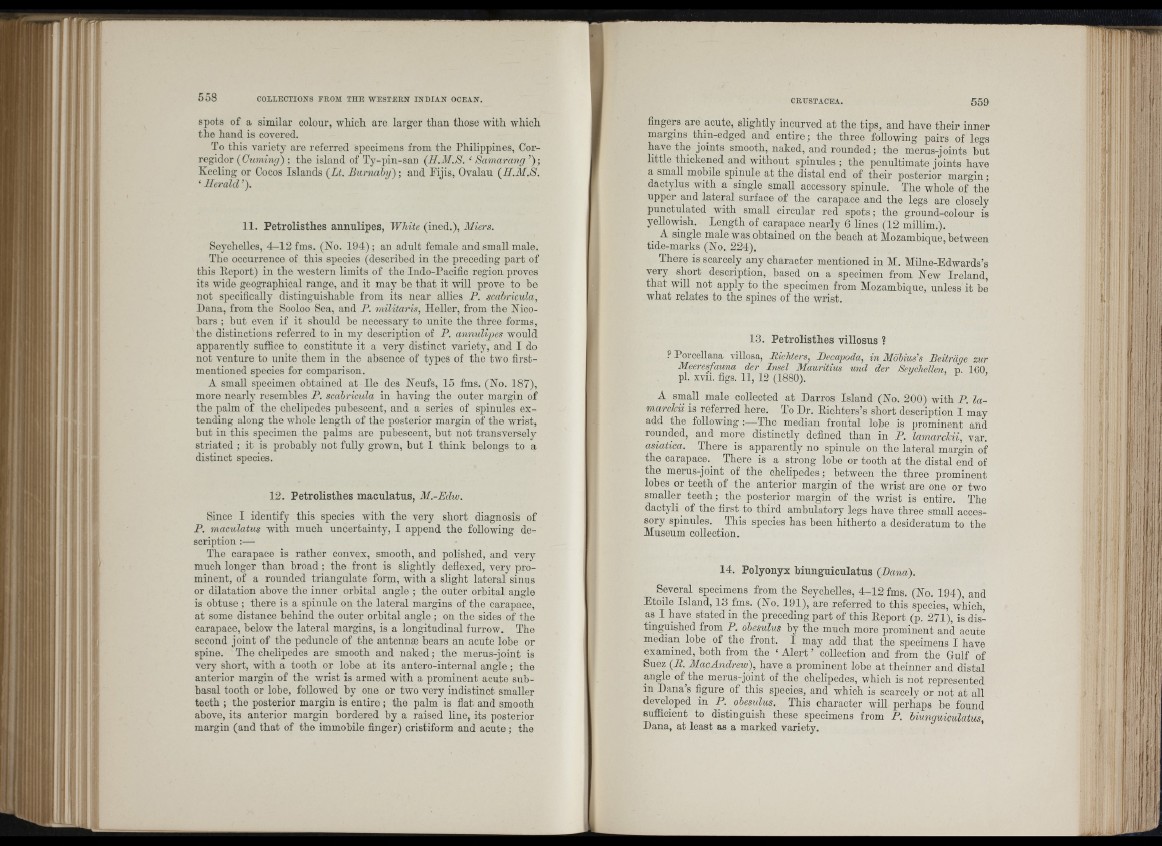
spots of a similar colour, which are larger than those with which
th e hand is covered.
To this variety are referred specimens from the Philippines, Corregidor
( ; the island of Ty-pin-san (H.Al.S. ‘ Samarang ’);
Keeling or Cocos Islands (Lt. Burnahy); and Pijis, Ovalau (H .ik.S .
‘ Herald ’).
I I
I I . Petrolisthes annulipes, White (ined.), Aliers.
Seychelles, 4 -12 fms. (No. 194) ; an adult female and small male.
The occurrence of this species (described in tbe preceding part of
this Keport) in the western limits of the Indo-Pacific region proves
its wide geographical range, and it may be th a t it will prove to be
not specifically distinguishable from its near allies P. scahricula,
Dana, from tbe Sooloo Sea, and P. militaris, Heller, from the Nico-
bars ; but even if it should be necessary to unite tbe three forms,
tbe distinctions referred to in my description of P. annulipes would
apparently sufiice to constitute it a very distinct variety, and I do
not venture to unite them in tbe absence of types of tbe two first-
mentioned species for comparison.
A small specimen obtained at He des Neufs, 15 fms. (No. 187),
more nearly resembles P. scahricula in having tbe outer margin of
the palm of tbe chelipedes pubescent, and a series of spinules extending
along the whole length of tbe posterior margin of tbe wrist,
but in tbis specimen tbe palms are pubescent, but not transversely
striated ; it is probably not fully grown, but 1 think belongs to a
distinct species.
12. Petrolisthes maculatus, AI.-Echu.
Since I identify tbis species with the very short diagnosis of
P. maculatus with mucb uncertainty, I append the following description
:—
Tbe carapace is ratber convex, smooth, and polished, and very
much longer than broad ; tbe front is slightly defiexed, very prominent,
of a rounded triangulate form, with a slight lateral sinus
or dilatation above the inner orbital angle ; tbe outer orbital angle
is obtuse ; there is a spinule on tlie lateral margius of the carapace,
at some distance behind tbe outer orbital angle ; on the sides of tbe
carapace, below the lateral margins, is a longitudinal furrow. The
second joint of the peduncle of tbe antennæ bears an acute lobe or
spine. The chelipedes are smooth and naked ; tbe merus-joint is
very short, with a tooth or lobe at its antero-internal angle ; tbe
anterior margin of the wrist is armed witb a prominent acute subbasal
tooth or lobe, followed by one or two very indistinct smaller
teeth ; tbe posterior margin is entire ; tbe palm is fiat and smooth
above, its anterior margin bordered by a raised line, its posterior
margin (and th at of the immobile finger) cristiform and acute ; tbo
fingers are acute, slightly incurved a t tbe tips, and bave tbeir inner
margins thm-edged and entire; the three following pairs of legs
have the joints smooth, naked, and rounded; tbe merus-joints but
little thickened and without spinules ; tbe penultimate joints bave
a small mobile spinule at tbe distal end of tbeir posterior m arg in ;
dactylus witb a single small accessory spinule. Tbe whole of tbe
upper and lateral surface of the carapace and the legs are closely
punctulated with small circular red spots; tbe ground-colour is
yellowish. Length of carapace nearly 6 lines (12 millim.).
A single male was obtained on the beach a t Mozambique, between
tide-marks (No. 224).
There is scarcely any character mentioned in M. Alilne-Edwards’s
very short description, based on a specimen from New Ireland,
th at will uot apply to the specimen from Alozamhique, unless it be
wbat relates to tbe spines of tbe wrist.
13. Petrolisthes villosus ?
? Porcellana villosa, Richters, Decapoda, in Alöbius's Beiträge zur
Aleeresfauna der Insel Alauritius und der Seychellen, n 160
pl. xvii. figs. 11, 12 (1880). ’
A small male collected at Darros Island (No. 200) witb P. la-
marclrii is referred here. To Dr. Kichters’s short description I may
add tbe following :—The median frontal lobe is prominent and
rounded, and more distinctly defined than in P. lamarclcii, var.
asiatica. There is apparently no spinule ou the lateral margin of
the carapace._ There is a strong lobe or tooth at the distal end of
the merus-joint of tbe chelipedes; between tbe three prominent
lobes or teeth of tbe anterior margin of tbe wrist are one or two
smaller te e th ; the posterior margin of tbe wrist is entire. Tbe
dactyli of tbe firs t/o third ambulatory legs bave three small accessory
spinules. This species has been hitherto a desideratum to tbe
Museum collection.
14. Polyonyx biunguiculatus (Dana).
Several specimens from the Seychelles, 4 -1 2 fms. (No. 194) and
Etoile Island, 13 fms. (No. 191), are referred to this species, which,
as I have stated in tbe preceding part of this Keport (p. 271), is dis^
tinguisbed from P. obesulus by the much more prominent and acute
median lobe of the front. I may add th at tbe specimens I bave
examined, botb from tbe ‘ Alert ’ collection and from the Gulf of
Suez (P. AlacAndrew), bave a prominent lobe at theinner and distal
angle of tbe merus-joint of tbe chelipedes, which is not represented
in Dana’s figure of this species, and wbicb is scarcely or not at all
developed in P . obesulus. Tbis character wiU perhaps be found
sufficient to distinguish these specimens from P. biunguiculatus,
Dana, at least as a marked variety. ’
J'
■■A ■; ' '(
« ■ 1
il
■Í- \
' ' i :
'Ì i 'Il
'}
Ij f
I
Í i
■ r l
A I t ; - '
■7 'i 'I - :
i 1
i'r U
J' ' M-
■I
tij
te ! A
r :